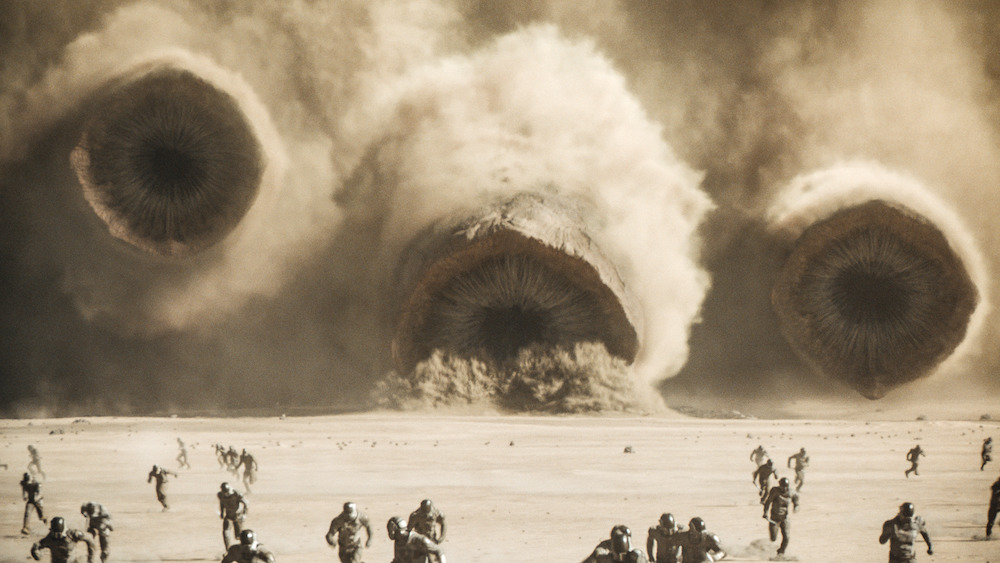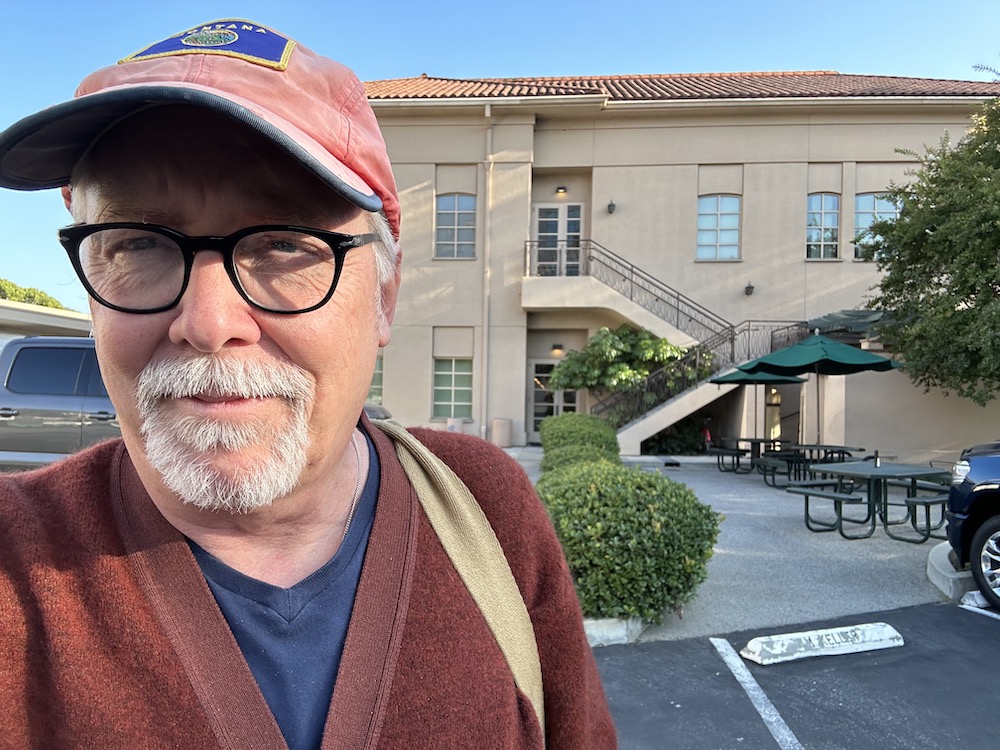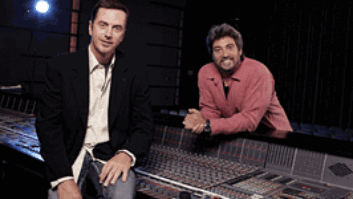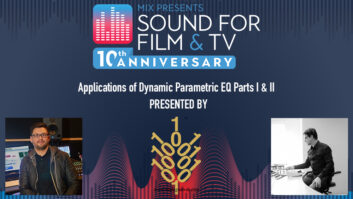
Amid a global pandemic, re-recording mixers Ron Bartlett and Doug Hemphill sat at the mixing console on Stage 9 at Warner Bros. Post Production Creative Services in Burbank, Calif., without their director. Denis Villeneuve was at home, trying to monitor the mix of Dune over headphones. “At some point, he said, ‘Gentlemen. I’m just going to have to trust you.’ That was tough, but we had his back,” Bartlett recalls.
The trust was well placed; Dune won the Oscar for Best Sound in 2022.
Although Covid-19 restrictions are no longer an issue, to say that mixing Dune: Part Two was easier would be selling Bartlett and Hemphill’s efforts short. Mixing hundreds of tracks—so many, in fact, that the Avid S6 consoles on Stage 9 needed to be supplemented with an Avid S3 for the end battle sequence—required diligence, humility and espresso. Lots of espresso. “The espresso machine is the piece of equipment that Denis loves best about Stage 9,” jokes Hemphill.
How does a mix team replicate the sonic success of a franchise’s previous film? By sticking to what worked before. For them, that meant being creative without being insecure, knowing that not all ideas would work out, but feeling safe enough to take risks and make mistakes.
“The arena scene with Feyd-Rautha Harkonnen is a spectacular sequence, and I mixed it as a spectacular sequence, which is like putting an exclamation mark on an exclamation mark,” says Hemphill, who mixed effects. “We all listened to it, and it didn’t work. We learned from that. I remixed it based on what the story is within that sequence, which is the Baron setting up Feyd to see if he’s got the right stuff to control the spice production on Arrakis. We established the big arena, and then we start to come down into the story with Feyd fighting the Atreides soldier. That was completely redone based on failure, but that’s one of the ways we’re allowed to work. We can make mistakes and then address what’s wrong to make it work.”
Finding the right path forward sometimes required making risky moves—like taking out all sound and music so a line of dialog could play unimpeded. The arena fight culminates with Feyd’s line, “You fought well today Atreides.” But the line was lost in a wash of enthusiastic Harkonnen crowds and composer Hans Zimmer’s dense score.
“We were trying to figure out what to do,” says Hemphill. “Finally, somebody just came up with the idea to take absolutely everything out when he says the line. It worked creatively, but it was also by necessity. We made this creative decision because the line was very hard to hear. Now it works like gangbusters.”
RIDING A SANDWORM
Big risk can mean big rewards, but the bigger the scene, the bigger the risk of losing important storytelling sounds if tracks are simply muted. Paul Atreides’ first attempt at riding a sandworm is one such epic scene that has it all: densely layered sound effects and massive score. Bartlett, who mixed dialogue and music, notes, “When you throw everything and the kitchen sink in there, it becomes a big mess. The sound effects play the epic size of this worm and how difficult it is for Paul to jump on and ride it. The big music lands when he stands up, but it didn’t work together all the way, so we had to do dramatic mix moves in that sequence to make it play properly.
“It took a few tries,” he adds. “First, we tried lowering sounds to make room for the music entrance, but we went too far. The worm disappeared; the power disappeared. Then we tried just having the wind, but it still lacked the power. It takes a lot of experimenting, sculpting and throwing ideas around to find what’s right. One idea can lead to another, and you ultimately find the right combination.”

On the effects side, Hemphill tried using a low-pass filter to take out high-end frequencies on the second wave of sand that engulfs Paul. “At that point, you’re ready for a sonic change, and it is here that Paul starts to subdue the worm and the music enters,” he explains. “Once we sculpted the moment that way—taking off the high-end—it was just a question of finding the degree to which we did it, then making a bridge to the music cue.”
The low-pass filter allowed the energy of the wind to be present, he adds, yet make room for the first synth note of the music coming in: “It transformed the sequence from being about the worm to being about Paul, who’s mastered riding it.”
Bartlett and Hemphill strove for dynamics in the mix, creating the contrast of quiet moments with powerful sonic events. For example, the lead-up scene to Paul’s sandworm ride is intimate and personal. The thumper (a device that summons the sandworms) has stopped, and it’s just the soft sound of Paul’s feet in the sand and the sound of his breathing as he anticipates its arrival.
“Doug [Hemphill] did a cool thing there,” Bartlett says. “You see the worm in the distance; it creates a cloud of dust as it punches through the sand. Everyone on the stage wanted to hear a bigger sound for the worm at that moment, but Doug was adamant about keeping what [supervising sound editor/sound designer] Richard King had done until the worm got closer. That sets up a great contrast of how big the worm sounds when it gets to Paul. If you played it loud when it’s distant, it takes away from that impact.”
Powerful sonic events don’t have to be painful ones, Bartlett adds, noting that it’s helpful to use the Dolby Atmos surround field to spread out some of the acoustic intensity of a big sequence—like a squadron of ornithopters flying toward a fight with the Fremen—as well as being conscious of brittle and painful high-end frequencies. “We will EQ those back and go for the low end to create size. We want it to feel huge; that’s the goal. The big battle near the end is one of those moments where we found a balance of size versus sound pressure levels.”
Hemphill worked with King to craft different low-end-heavy booms. “We’d even tune the boom,” he notes. “Sometimes we’d ride the boom frequency in the middle of a low-end event so it would change color.”
USING THE FULL ATMOS FIELD
While big action scenes may seem like the best opportunities for showcasing the Atmos format, Bartlett feels the quieter moments, with just ambiance and a few specific sounds, work better for conveying space and depth. Hemphill agrees: “It’s an audio-acoustic fact that as sound pressure level increases, imaging decreases. If you were to play something in Atmos that was really big, it would essentially just sound mono. As you get into these quieter sound levels, you can hear the imagery better.”
Atmos is especially useful in subjective moments when non-diegetic sounds can be moved around in space to create an intended feeling or emotion for a scene. For example, Feyd finds Lady Margot Fenring roaming an off-limits hallway of the palace, and when he confronts her, she casts her Bene Gesserit spell on him. Her voice feels as if it’s coming from everywhere and nowhere; it plays inside Feyd’s mind. Bartlett says, “I wanted to achieve that slowly, and not do it noticeably. Like a lobster in a pot of water, he’s slowly getting cooked.”
For Lady Margot’s vocal processing, Bartlett used The Cargo Cult’s Slapper for tight delays and added a bit of chorus effect so that her voice feels heady, yet close and intimate at times. Spatial panning in Atmos helped to detach the sound from the character, specifically during wide shots. And when they wanted it to feel like she was right next to Feyd’s ear, telling him to put his hand in the box, Bartlett pulled her voice into the front channels and removed her vocal processing.
“In the wider shots in the hallway, while she’s doing the snake charmer thing to Feyd, I used soft, long delays and long reverb from LiquidSonics Cinematic Rooms, but it was low in the mix,” he explains. “It’s not a big room reverb; it’s more whispery. It has a long echo, so you’ll hear it two or three times, but very subtly. I played with both of those constructs in the sequence.”
During another subjective sound sequence in which Lady Jessica, mother of Paul Atreides, drinks the Water of Life, Bartlett spread the music stems from scoring mixer Alan Meyerson into the surround field, giving Hemphill room up front for the effects. Hemphill says, “From Denis’ point of view, that needed to have a certain energy arc, so we were picking our moments within the scene.”

Bartlett elaborates: “When the blue fluid is moving through Jessica’s body, that’s a moment for effects. When she opens her eyes and they are blue, we really hit that. We try to find the signposts along the way and use those to shape our sounds. If Doug has this great low-end hit from Richard, I don’t need to double-hit that with music; it’s like a hat on a hat. Instead, I’ll pull the music back and let them hit that with effects, then I’ll come in with a crazy vocal or a distorted sound afterward.”
Lady Jessica (named Reverend Mother after surviving the Water of Life) unleashes her commanding Bene Gesserit voice at times, like when she orders the temple’s Maker Keeper to “Let him try!” To beef up her performance, Bartlett used his own voice, recorded at his home studio during the premix.
“We were under the wire and had so much work to do, so I hung a mic and did some crazy voice work,” Bartlett says. “Sometimes Jessica’s voice would echo out, and other times it was more like a weapon—very sharp and short. Some lines, like ‘Find them,’ were more forceful and guttural, while other lines were more wispy. I matched my performance to Jessica’s, like ADR, and used zplane’s Elastique Pitch V2 to pitch it down, then applied dynamic EQ with FabFilter’s Pro-Q 3. Martin Kwok, our dialog supervisor, and I then added in the witchy Bene Gesserit voices that we had from actress Charlotte Rampling (who plays Reverend Mother Mohiam), tailoring the performance and processing to what the scenes required.”
Some of the most powerful scenes in the film are on the quiet side, one example being when Paul is sent into the desert to prove that he can survive. He’s alone. The desert winds sing across the sand. Chani (played by Zendaya) follows him out there and teaches him how to sand walk like a native, not as he learned from old films.
“That’s a delicate, beautiful sequence that I just love,” Hemphill says. “Denis was very much into the sound of sand and footsteps. Dan O’Connell (Foley artist) recorded footsteps on the Foley stage, and Eric Potter and Charlie Campagna went out and did recordings of sand footsteps. Richard [King] and Charlie recorded cool footsteps for when they’re going down the side of the dune—you hear this low, undulating sound of the sand shifting deep underneath them. Charlie and Eric also recorded sounds for the Fremen bursting through the sand.”
SOUND AS A TEAM APPROACH
Creating the sound of Dune: Part Two was a huge team effort. While there are too many people to name here, Hemphill and Bartlett note the contributions and support from team members such as sound designer Dave Whitehead and supervising dialogue/ADR editor Martin Kwok, working from New Zealand, who helped create the entire Fremen language of Chakobsa and all of the arena scene and crowds; first assistant sound editor Andrew Bock and re-recording mix technician Unsun Song, who provided support on the dub stage; and Kim Waugh and the engineering team of Tony Pilkington and Ryan Murphy at Warner Bros. Post.
On the music side, there were supervising music editors Clint Bennett and Ryan Rubin, as well as scoring mixer Meyerson. “We also had Valerie Flueger Veras (Head of Post Production) at Legendary Entertainment and Tina Anderson (Post-Production Supervisor) providing incredible support—and we certainly had the support of our director Denis,” says Hemphill.
Bartlett attests, “Denis loves being on our dub stage. He loves the process of putting it all together. You can just see the passion in his face; he’s so excited to start the day. He leads by example and sets the tone. You just want to do your best for the guy.”
Villeneuve is even there for the very first run-through, when the separate dialog and effects pre-dubs are combined with the final score. “We do what’s called a ‘crash and burn,’ which is playing everything once through straight the first time, to get a feel for what we’ve got,” says Hemphill. “God willing, it gets better from there!”
Maestro Mixer Steve Morrow Talks Dense Dialogue and Music
After Bartlett and Hemphill had completely worked out each scene detail by detail in the Dolby Atmos mix, there was still more work to do—namely downmixes. “There are about 20 masters of the film,” Bartlett explains. “For theatrical release, we downmixed to IMAX 12.0 and 5.0, and then 5.1, 7.1, and two-track—and then we redid all of those in near-field, except IMAX, of course. The hardest thing is to crush a movie this big into near-field specs. Some of the near-field specs are insane.”
Hemphill adds, “Interestingly, Denis was very happy with the 5.1 mix. Ron and I are very proud that we got all of the Atmos bells and whistles down to the 5.1 mix and our director was still very pleased.”
Because the COVID-19 pandemic was still in full swing when Dune (2021) was released, it streamed on HBO Max on the same day it premiered in U.S. theaters. That’s not the ideal release schedule for such a cinematic sci-fi film. As Hemphill notes, Villeneuve’s goal is to get people into theaters, to have that collective experience of watching a story together. Fortunately, Dune: Part Two was released only in theaters with a streaming date yet to be set. Bartlett concludes, “We mixed for a theater experience; it’s really meant to play in the theater because it’s that epic of a film.”






